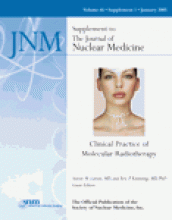Abstract
Regulatory peptide receptors are overexpressed in numerous human cancers. These receptors have been used as molecular targets by which radiolabeled peptides can localize cancers in vivo and, more recently, to treat cancers with peptide receptor radiation therapy (PRRT). This review describes the candidate tumors eligible for such radiotherapy on the basis of their peptide receptor content and discusses factors in PRRT eligibility. At the present time, PRRT is performed primarily with somatostatin receptor- and cholecystokinin-2 (CCK2)-receptor-expressing neuroendocrine tumors with radiolabeled octreotide analogs or with radiolabeled CCK2-selective analogs. In the future, PRRT may be extended to many other tumor types, including breast, prostate, gut, pancreas, and brain tumors, that have recently been shown to overexpress several other peptide receptors, such as gastrin-releasing peptide-, neurotensin-, substance P-, glucagon-like peptide 1-, neuropeptide Y-, or corticotropin-releasing factor-receptors. A wide range of radiolabeled peptides is being developed for clinical use. Improved somatostatin or CCK2 analogs as well as newly designed bombesin, neurotensin, substance P, neuropeptide Y, and glucagon-like peptide-1 analogs offer promise for future PRRT.
Footnotes
Received Apr. 23, 2004; revision accepted Sep. 30, 2004.
For correspondence or reprints contact: Jean Claude Reubi, MD, Division of Cell Biology and Experimental Cancer Research, Institute of Pathology, University of Berne, P.O. Box 62, Murtenstrasse 31, CH-3010 Berne, Switzerland.
E-mail: reubi{at}pathology.unibe.ch







